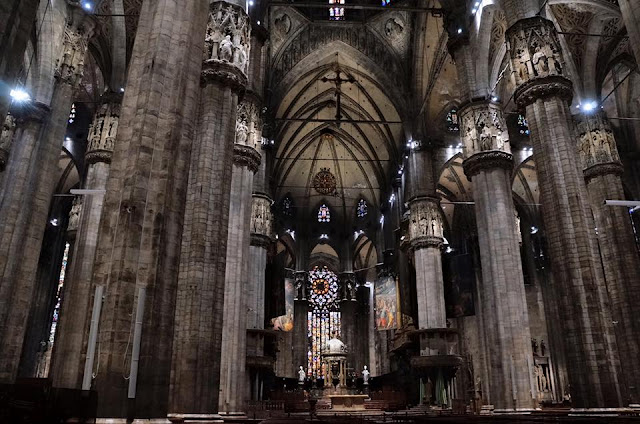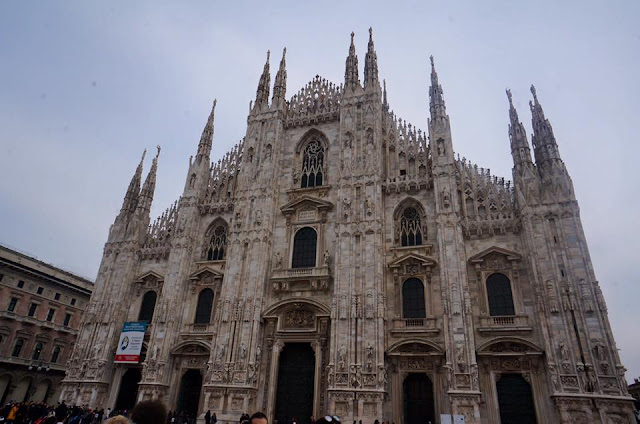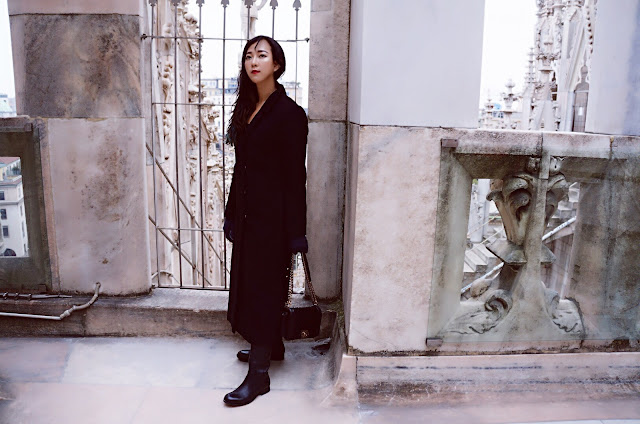MILAN Milan was the Western Roman Empire's capital for a short but significant 109 years. Its position at the top was reconfirmed by Napoleon in 1786, when he declared the city his centre of the Cisalpine Republic. Rome was chosen, some say arbitrarily, as Italy's capital in 1861. But for most northern Italians, Milan is the country's heart.
Milan is Italy's business capital, home to the country's stock exchange as well as its renowned fashion and design industries. But while people work hard, they play hard too. Whether you're up for eating or drinking, football or shopping, Milan excels at recreation.
You won't be dashing from street to street ticking sights off a must-see list, as in Florence, but cultural gems are hardly few and far between. The city is home to Leonardo da Vinci's Last Supper (Santa Maria delle Grazie & The Last Supper). Arguably the artist's finest achievement, it was miraculously spared from Second World War bombing as the building around it fell.
Caravaggio's 'Basket of Fruit' hangs in the Pinacoteca Ambrosiana, while his 'Supper at Emmaus' graces the Pinacoteca Brera. The restored Duomo is a majestic Gothic folly that took half a millennium to complete. But the city's charms can also be understated: there are pleasures in its dusty churches, on the narrow streets of the Brera district, and in courtyards glimpsed through wrought-iron gates.
The so-called Fashion Rectangle is lined with D&G, Versace and Armani boutiques, but you'll delight as much in the stores of local designers. There's not a seat free during the biannual derby at the San Siro Stadium, home to both AC Milan and FC Internazionale. The feast day of Sant'Ambrogio, the city's patron saint, is such a celebration that a massive street fair shuts down a whole neighbourhood. The date also marks the opening night of La Scala's opera season.
On the flip side? The euro has caused the city to become more expensive. The pollution can be oppressive: on a good day, you'll see the Alps from the roof of the Duomo, but on a bad day, city driving is restricted according to number plates in an ongoing attempt to lower vehicle emissions. Local politics can be chaotic, with issues so complex that they're often unintelligible even to the Milanese.
There are also those who claim that Milan is overly urban and unlike the rest of Italy. There may be some truth in this, but chatty barmen still serve cappuccinos with heart-shaped froth to their female customers, and the markets' vegetable vendors succeed in bringing the countryside to Milan and forcing the city slickers to slow their pace for a moment.
Those who look beyond the glamour will discover a city that strides out in style. Locals look to the future, whether it be the 2015 Expo or next season's fashion catwalks. They just sometimes need tourists to show them what a treasure they have right here, right now.
Take in the view from the Duomo roof
500 years in the making, the spiked gothic cathedral that is the Duomo has been compared to a wedding cake and a ‘hedgehog’ (D.H. Lawrence). Its imposing interior contains some magnificent treasures but, for a truly breathtaking experience, climb the 150 steps (or take the lift) to the roof. Here, visitors can admire some of the 3,600 statues and 135 spires, many carved from pink Candoglia marble – and get a closer view of the famous gilded copper ‘Madonnina’ atop the tallest spike. On a fine day, the view stretches far beyond the city to the snow-capped Alps.
 |
 |
| Acording the lengendary turn three round at the bulls's reproductive ogan,the bad luck will away from you;good luck will follow you |
 |
 |
SHOPPING
By Tristan Rutherford and Kathryn Tomasetti
Along with design and finance, fashion is the city's biggest draw. Its influence spreads to the worlds of publishing, dining, partying and commerce, so you'll be hard pressed to avoid it. What's more, people do actually wear the wacky garments you see paraded at the city's twice-yearly fashion weeks: many a Milan street looks like a photo shoot for Italian Vogue.
But what's di moda in the fashion capital one month becomes 'so last season' the next, which means a wealth of cast-offs at the many outlets and seconds stores; and because styles generally reach London and New York around a year after launch in Italy, if you fly home laden with shopping bags, you'll be up to date for a while yet. Guilds as diverse as jewellers, pasticcerie (speciality bakers) and milliners (who derive their name from the city) have catered to a discerning elite for half a millennium, so quality and choice are superb.
Where to shop for... big names
Milan is a haute couture powerhouse, where fashions jump from catwalk to clothes rail in weeks. But unlike the sprawling fashion district in Paris, Milan's boutiques fit into a square known as the Quadrilatero d'Oro ('rectangle of gold'):
Via della Spiga
D&G accessories, no.2; Fendi, no.9; Prada accessories, no.18; Armani accessories, no.19; D&G woman, no.26; Just Cavalli, no.30; Byblos, no.33; Roberto Cavalli, no.42; Marni, no.50.
Via Manzoni
Armani Superstore, no.31; Paul Smith, no.32; Armani Casa, no.37.
Via Sant'Andrea
Missoni, no.2; Trussardi, no.5; Kenzo, no.9; Giorgio Armani, no.9; Chanel, no.10; Moschino, no.12; Gianni Versace, no.14; Gianfranco Ferré, no.15; Barbara Bui, no.17; Miu Miu, no.21; Hermès, no.21; Prada sport, no.21.
Via Montenapoleone
La Perla, no.1; Louis Vuitton, no.2; Ralph Lauren, no.4; Bottega Venezia, no.5; Sergio Rossi, no.6; Gucci, no.7; Prada women, no.8; Armani Junior, no.10; Gianni Versace, no.11; Valentino, no.20; Alberta Ferretti, no.21; Christian Dior, no.21.
Even if the price tags are larger than your budget, you can spend many a happy hour admiring the window displays. And if you can only just afford €500 on a pair of Miu Miu boots, rest assured: the shopkeepers will happily accept plastic.
And when you've shopped your heart out, Caffè Baglioni, with its private entrance at via della Spiga 6, is a chic spot to stop. The area is best reached from metro Montenapoleone or San Babila, by bus 61 or 94, or tram 1, 2 or 20.
Gallerie Vittorio Emanuele II
Another historic shopping spot is the Galleria Vittorio Emanuele II, the glass-roofed arcade near the Duomo. It opened in 1867, which makes it one of the oldest shopping malls in the world. Prada's flagship store has been in business here since 1913, joined more recently by Louis Vuitton and Gucci.
Where to shop for... alternative & high street labels
Anyone with a big-brand allergy should head to the smaller, more alternative stores on corso di Porta Ticinese or in Brera. Other zones worth a look are corso Vercelli (the western extension of corso Magenta) and the Isola area, behind Stazione Garibaldi. For the Italian version of high-street shopping, try corso Buenos Aires, via Torino or corso Vittorio Emanuele; many of the shoppers on these streets may still look intimidatingly smart, but head-to-toe Versace is not obligatory.
Where to shop for... designer bargains
There are many ways to bag a bargain throughout the city, if you know where to look. Shops selling end-of-season returns, catwalk cast-offs and seconds abound, as do second-hand and vintage clothes boutiques. You'll also find heart-stopping deals in the markets, from Gucci shoes to cashmere jumpers.
The Milanese joke that only tourists shop at the Prada flagship store in the Galleria Vittorio Emanuele II. Locals, on the other hand, prefer the city's many outlet stores, and are prepared to elbow their way through rack after rack of cut-price catwalk fashions to find the best bargains.
Such treasure troves are packed full of end-of-season shop and warehouse returns, stock from boutiques that have closed down, and some factory seconds. There's one drawback: even at discounts of 50-70 per cent, the price tags can still provoke the occasional 'Ouch!' Also, bear in mind that refunds are pretty much unheard of, so try before you buy.
Try the outlets around the corso Vittorio Emanuele II. They employ none too subtle marketing gimmicks to ratchet up the thrill of the hunt, like letting a queue form outside the store, or sealing your handbag inside a special security bag so you're not tempted to snaffle any of the awesome bargains. Serious shopaholics should invest in a copy of the factory outlets bible Scoprioccasioni (www.scoprioccasioni.it; also available in English at Milan's major bookstores), which lists over 1,000 reputable establishments.
Among Milan's best known and longest established outlets is Il Salvagente('the lifesaver'), which has three floors of top stuff for men and women, all carefully arranged by size and colour; for children there's a separate location called Salvagente Bimbi (Via Balzaretti 28, Easy, 02 2668 0764). Equally worthwhile bargains can be found at discount outlets with more convenient, central locations – places like Dmagazine Outlet, wedged between the full-price stores on the city's main shopping drag. It's small, hot and hectic, with some pricey women's lines (€500 per item for the likes of Miu Miu and Marni) for as little as 20 per cent of their original value. Be prepared to dig deep; for men's lines it's best to try elsewhere.
Basement – housed, as the name suggests, in a cellar – is for women's fashion only. It caters to a more upmarket shopper, and is more boutique, less snakepit. Come here for price slashes of 50-70 per cent on brands including Dolce & Gabbana, Prada and YSL.
Top tips
Vogue readers on a budget: head for the 10 Corso Como Outlet, a slightly shabbier version of the übercool original store (10 Corso Como), with endless racks of mostly black clothes by Helmut Lang, Chloé, Comme des Garçons et al. But even with prices slashed by half, it's expensive.
Out-of-town outlets: many tourist offices around the lakes keep flyers handy for the big out-of-town outlets. These have many more discounted brand shops under one roof: one example is the mega 250-store Fox Town (+41 (0)848 828 888, www.foxtown.ch) in Mendrisio, just across the Swiss border from Lago di Como.
End-of-season sales: these sales, strictly sanctioned by the local government for a few weeks each January and July, are a bargain hunter's heaven.
Opening hours
Traditionally, Tuesday to Saturday retail hours are 9.30am-12.30pm and 3.30-7.30pm, with a half day on Monday (3.30-7.30pm). The majority of shops still close on Sundays, though fashion stores stay open during the major fairs, and, in these cash-starved times, at other times throughout the year. Few shops in central Milan still close for lunch, but much of the city shuts down in August. Sales take place at state appointed times in January and July.
Tax refunds
Non-EU residents can claim back the value added tax ('IVA' in Italian) on purchases totalling over €154.94 from a single store that displays a 'Tax-Free Shopping' sign. To do so, ask for a 'VAT back' form at the moment of purchase, keep your receipts, and pack your unworn new goods at the top of your suitcase (you may have to show them). Then have the receipts stamped at customs when you leave Italy, and hand over your 'VAT back' paperwork. Next, head for a refund centre (those at Malpensa and Linate airports are open 7am-11pm and 6am-10pm daily, respectively); or post the paperwork when you get back home.
There's also a tax-free centre on the basement level of La Rinascente department store, where you can get your cash back before leaving the country (9am-10pm Mon-Sat, 10am-10pm Sun). However, you'll still have to queue to clear documents at the airport. For more details, go to www.globalrefund.com.
While every effort and care has been made to ensure the accuracy of the information contained in this guide, the publisher cannot accept responsibility for any errors it may contain. Before you go out of your way, we strongly advise you to phone ahead and check the particulars.
See all shops in Milan

























No comments:
Post a Comment